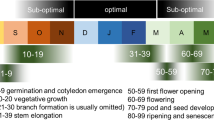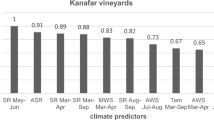Abstract
Across the world, wine grape phenology has advanced in recent decades1,2,3, in step with climate-change-induced trends in temperature—the main driver of fruit maturation—and drought. Fully understanding how climate change contributes to changes in harvest dates, however, requires analysing wine grape phenology and its relationship to climate over a longer-term context, including data predating anthropogenic interference in the climate system. Here, we investigate the climatic controls of wine grape harvest dates from 1600–2007 in France and Switzerland using historical harvest4 and climate data5,6,7. Early harvests occur with warmer temperatures (−6 days °C−1) and are delayed by wet conditions (+0.07 days mm−1; +1.68 days PDSI−1) during spring and summer. In recent decades (1981–2007), however, the relationship between harvest timing and drought has broken down. Historically, high summer temperatures in Western Europe, which would hasten fruit maturation, required drought conditions to generate extreme heat. The relationship between drought and temperature in this region, however, has weakened in recent decades and enhanced warming from anthropogenic greenhouse gases can generate the high temperatures needed for early harvests without drought. Our results suggest that climate change has fundamentally altered the climatic drivers of early wine grape harvests in France, with possible ramifications for viticulture management and wine quality.
This is a preview of subscription content, access via your institution
Access options
Subscribe to this journal
Receive 12 print issues and online access
$209.00 per year
only $17.42 per issue
Buy this article
- Purchase on Springer Link
- Instant access to full article PDF
Prices may be subject to local taxes which are calculated during checkout




Similar content being viewed by others
References
Duchêne, E. & Schneider, C. Grapevine and climatic changes: a glance at the situation in Alsace. Agron. Sustain. Dev. 25, 93–99 (2005).
Seguin, B. & de Cortazar, I. G. Climate warming: consequences for viticulture and the notion of ‘terroirs’ in Europe. Acta Hort. 689, 61–69 (2005).
Webb, L. B., Whetton, P. H. & Barlow, E. W. R. Observed trends in winegrape maturity in Australia. Glob. Change Biol. 17, 2707–2719 (2011).
Daux, V. et al. An open-access database of grape harvest dates for climate research: data description and quality assessment. Clim. Past 8, 1403–1418 (2012).
Luterbacher, J., Dietrich, D., Xoplaki, E., Grosjean, M. & Wanner, H. European seasonal and annual temperature variability, trends, and extremes since 1500. Science 303, 1499–1503 (2004).
Cook, E. R. et al. Old World megadroughts and pluvials during the common era. Sci. Adv. 1, e1500561 (2015).
Pauling, A., Luterbacher, J., Casty, C. & Wanner, H. Five hundred years of gridded high-resolution precipitation reconstructions over Europe and the connection to large-scale circulation. Clim. Dynam. 26, 387–405 (2006).
Jones, G. V. & Davis, R. E. Climate influences on grapevine phenology, grape composition, and wine production and quality for Bordeaux, France. Am. J. Enol. Vitic. 51, 249–261 (2000).
Schultz, H. R. & Jones, G. V. Climate induced historic and future changes in viticulture. J. Wine Res. 21, 137–145 (2010).
Tomasi, D., Jones, G. V., Giust, M., Lovat, L. & Gaiotti, F. Grapevine phenology and climate change: relationships and trends in the Veneto region of Italy for 1964–2009. Am. J. Enol. Vitic. 62, 329–339 (2011).
Camps, J. O. & Ramos, M. C. Grape harvest and yield responses to inter-annual changes in temperature and precipitation in an area of north-east Spain with a Mediterranean climate. Int. J. Biometeorol. 56, 853–864 (2012).
Webb, L. B. et al. Earlier wine-grape ripening driven by climatic warming and drying and management practices. Nature Clim. Change 2, 259–264 (2012).
Jones, G. V. in Phenology: An Integrative Environmental Science (ed. Schwartz, M. D.) 563–584 (Springer, 2013).
Jones, G. V., White, M. A., Cooper, O. R. & Storchmann, K. Climate change and global wine quality. Climatic Change 73, 319–343 (2005).
Mori, K., Goto-Yamamoto, N., Kitayama, M. & Hashizume, K. Loss of anthocyanins in red-wine grape under high temperature. J. Exp. Bot. 58, 1935–1945 (2007).
Chaves, M. M. et al. Grapevine under deficit irrigation: hints from physiological and molecular data. Ann. Bot. 105, 661–676 (2010).
Baciocco, K. A., Davis, R. E. & Jones, G. V. Climate and Bordeaux wine quality: identifying the key factors that differentiate vintages based on consensus rankings. J. Wine Res. 25, 75–90 (2014).
Van Leeuwen, C. et al. Vine water status is a key factor in grape ripening and vintage quality for red Bordeaux wine. How can it be assessed for vineyard management purposes? J. Int. Sci. Vigne Vin 43, 121–134 (2009).
Coombe, B. G. Influence of temperature on composition and quality of grapes Symp. Grapevine Canopy Vigor Manage., XXII IHC 206, 23–36 (International Society for Horticultural Science, 1986).
Fila, G., Tomasi, D., Gaiotti, F. & Jones, G. V. The book of vinesprouts of Kőszeg (Hungary): a documentary source for reconstructing spring temperatures back to the eighteenth century. Int. J. Biometeorol. 60, 207–219 (2015).
Harris, I., Jones, P. D., Osborn, T. J. & Lister, D. H. Updated high-resolution grids of monthly climatic observations–the CRU TS3.10 dataset. Int. J. Climatol. 34, 623–642 (2014).
Broadbent, M. Vintage Wine: Fifty Years of Tasting Three Centuries of Wine (Harcourt, 2002).
Oppenheimer, C. Climatic, environmental and human consequences of the largest known historic eruption: Tambora volcano (Indonesia) 1815. Prog. Phys. Geogr. 27, 230–259 (2003).
Rebetez, M. et al. Heat and drought 2003 in Europe: a climate synthesis. Ann. Forest Sci. 63, 569–577 (2006).
Chuine, I. et al. Historical phenology: grape ripening as a past climate indicator. Nature 432, 289–290 (2004).
Seneviratne, S. I., Luthi, D., Litschi, M. & Schar, C. Land-atmosphere coupling and climate change in Europe. Nature 443, 205–209 (2006).
Parker, A. et al. Classification of varieties for their timing of flowering and veraison using a modelling approach: a case study for the grapevine species Vitis vinifera L. Agric. Forest Meteorol. 180, 249–264 (2013).
van Leeuwen, C. & Darriet, P. The impact of climate change on viticulture and wine quality. J. Wine Econ. http://dx.doi.org/10.1017/jwe.2015.21 (2016).
Jackson, D. I. & Lombard, P. B. Environmental and management practices affecting grape composition and wine quality-a review. Am. J. Enol. Vitic. 44, 409–430 (1993).
van Leeuwen, C. et al. Why climate change will not dramatically decrease viticultural suitability in main wine-producing areas by 2050. Proc. Natl Acad. Sci. USA 110, E3051–E3052 (2013).
de Cortazar-Atauri, I. G. et al. Climate reconstructions from grape harvest dates: methodology and uncertainties. Holocene 20, 599–608 (2010).
Palmer, W. C. Meteorological Drought Research Paper No. 45 58 (US Weather Bureau, 1965).
van der Schrier, G., Barichivich, J., Briffa, K. R. & Jones, P. D. A scPDSI-based global dataset of dry and wet spells for 1901–2009. J. Geophys. Res. 118, 4025–4048 (2013).
R Core Team R: A Language and Environment for Statistical Computing (R Foundation for Statistical Computing, 2014); http://www.R-project.org
Acknowledgements
The authors thank I. García de Cortázar-Atuari for help with the Daux data, H. Eyster, S. Gee and J. Samaha for extracting wine quality data and K. Nicholas for comments on an earlier draft. LDEO contribution no. 7976.
Author information
Authors and Affiliations
Contributions
B.I.C. and E.M.W. conceived of the paper and contributed equally to the writing. B.I.C. conducted the climate analyses and processing of the harvest data, with contributions from E.M.W. E.M.W. performed the wine quality analysis.
Corresponding author
Ethics declarations
Competing interests
The authors declare no competing financial interests.
Supplementary information
Supplementary Information
Supplementary Information (PDF 2463 kb)
Rights and permissions
About this article
Cite this article
Cook, B., Wolkovich, E. Climate change decouples drought from early wine grape harvests in France. Nature Clim Change 6, 715–719 (2016). https://doi.org/10.1038/nclimate2960
Received:
Accepted:
Published:
Issue Date:
DOI: https://doi.org/10.1038/nclimate2960
This article is cited by
-
The written history of plant phenology: shaping primary sources for secondary publications
The Science of Nature (2023)
-
Near-real-time drought monitoring and assessment for vineyard production on a regional scale with standard precipitation and vegetation indices using Landsat and CHIRPS datasets
Asia-Pacific Journal of Regional Science (2023)
-
Effects of climate change on bioclimatic indices in vineyards along Lake Neuchatel, Switzerland
Theoretical and Applied Climatology (2022)
-
Towards a rigorous understanding of societal responses to climate change
Nature (2021)
-
Climate change risks and adaptation: new indicators for Mediterranean viticulture
Mitigation and Adaptation Strategies for Global Change (2020)



